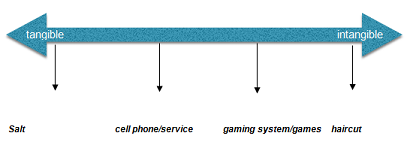Assignment
TOPIC 1: Product Descriptions
As we have been noting in earlier weeks, "product" is a generic term to mean tangible goods, services, or ideas. Most products are a combination of tangible goods and service and fall somewhere on a continuum like this:

Select one of your favorite products and describe it terms of its:
• features
• benefits
• price
• total cost of ownership
Be sure you refer to these concepts in the week's readings before tackling this description.
• Then, identify where your product would fall on the product/service continuum and why you chose that location. Use percentages such as 25 percent product and 75 percent service.
• Lastly, does the product have any product lines? If so, how do they differ from the "core product" in terms of additional benefits or features?
Comment on at least one of the posts of classmates if you are familiar with products they have chosen and what your thoughts are on the description and the continuum choice. Use a minimum of one reference to support your remarks.
TOPIC 2: Types of Consumer Offerings
This section of the week's readings describes the types of consumer offerings with four categories:
1. Convenience offerings
2. Shopping offerings
3. Specialty offerings
4. Unsought offerings
Consider your own purchase behaviors. Identify a product that, for you, falls into each of the four categories. Be sure to consider why you chose each of the categories for each product and share that with your professor and classmates.
As you read through your classmates' posts, you will most likely notice that the same product can be a different category for different customers; if so, share your observations with your classmates.
Interact with at least one classmate and use a minimum of one reference.
TOPIC 3: Product Life Cycle
The value of the product life cycle is that it provides clues as to what marketing mix strategies might need to change as the product moves through the cycle. For example, a high-tech product being launched will have to decide whether to use penetration or skimming pricing strategy. That pricing strategy will then determine how much marketing communications is needed and what distribution strategy is needed. Because high-tech products are particularly susceptible to competition and entry of substitute products, the company needs to stimulate sales early, knowing the product life cycle may be short.
Pick one of the following products and identify which stage of the life cycle you believe it is in and why. You don't need to do research; just use your personal experience and judgment. You may want to check out the product's website. Then, identify what needs to be done to the marketing mix based on the stage you selected.
1. Apple iWatch
2. Kellogg All-Bran cereal
3. Crest Complete toothpaste
4. Ford Focus automobile
5. Häagen-Dazs ice cream
6. Libby Sweet Peas canned vegetables
7. Rolling Barn Door Hardware by CSH
8. Beyond Meat Chicken Free Strips
Since each of you are picking different products, scroll through some responses and see if you have a different point of view and post as appropriate.
You don't need to respond to another student; however, you need to use at least one reference.
Format your assignment according to the following formatting requirements:
1. The answer should be typed, double spaced, using Times New Roman font (size 12), with one-inch margins on all sides.
2. The response also include a cover page containing the title of the assignment, the student's name, the course title, and the date. The cover page is not included in the required page length.
3. Also Include a reference page. The Citations and references should follow APA format. The reference page is not included in the required page length.